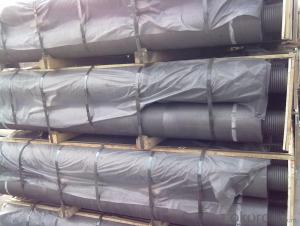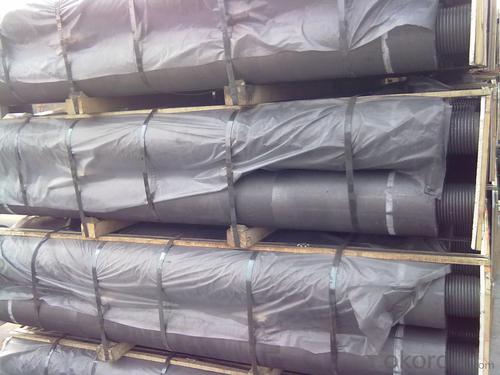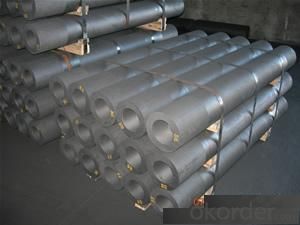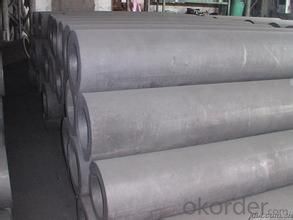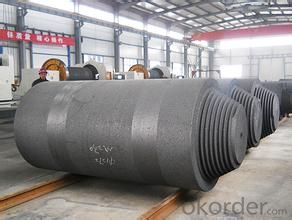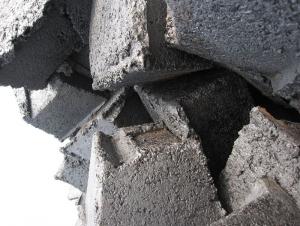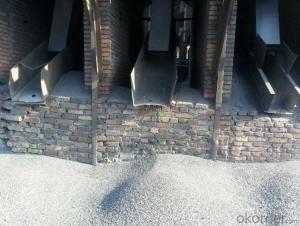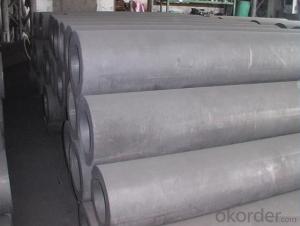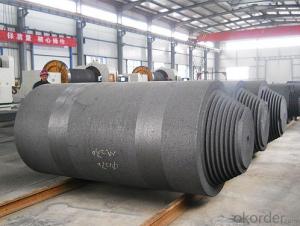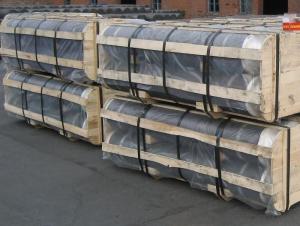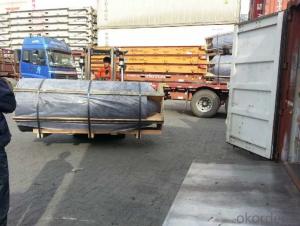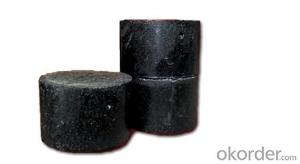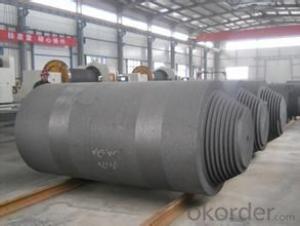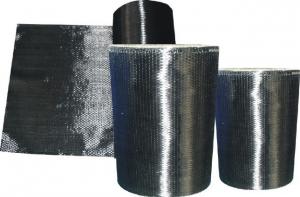Carbon Electrodes with Diameter Φ500 to Φ700
- Loading Port:
- Lianyungang
- Payment Terms:
- TT OR LC
- Min Order Qty:
- 20 m.t.
- Supply Capability:
- 700 m.t./month
OKorder Service Pledge
OKorder Financial Service
You Might Also Like
Spcifications
1:carbon eletrode
2:for ferroalloy,calcium carbide, silicon metal, manufacture
Product Description
Carbon Electrode is abaked electrode used in submerged arc furnaces for delivering power to the charge mix. Electrode is added to the top of the electrode column cylindrical form. Electrode is essentially a mix of Electrically Calcined Anthracite (ECA) or Calcined Petroleum Coke (CPC) with Coal Tar Pitch and is baked for weeks, it is widly used for ferroally productiong, silicon metal production etc.
Graphite/Carbon Electrode Paste Specification:
| PARAMETER UNIT GUARANTEE VALUE | ||||||
| Items | Φ500~Φ700 | Φ750~Φ960 | Φ1020~Φ1400 | |||
| Rs μΩ.m | ≤45 | ≤38 | ≤45 | ≤38 | ≤40 | |
| Bulk Desity g/cm3 | ≥1.55 | ≥1.58 | ≥1.55 | ≥1.58 | ≥1.55 | ≥1.58 |
| Bending Strength MPa | 3.5~7.5 | 4.0~7.5 | 3.5~7.5 | 4.0~7.5 | 3.5~7.5 | 4.0~7.5 |
| Compressive Strength MPa | ≥20.0 | ≥20.0 | ≥20.0 | ≥20.0 | ≥19.0 | ≥19.0 |
| Compressive Strength MPa | 3.2~4.8 | 3.0~4.6 | 3.2~4.8 | 3.0~4.6 | 3.2~4.8 | 3.0~4.6 |
| Ash % | ≤2.5 | ≤2.0 | ≤2.5 | ≤2.0 | ≤2.5 | ≤2.0 |
Picture:
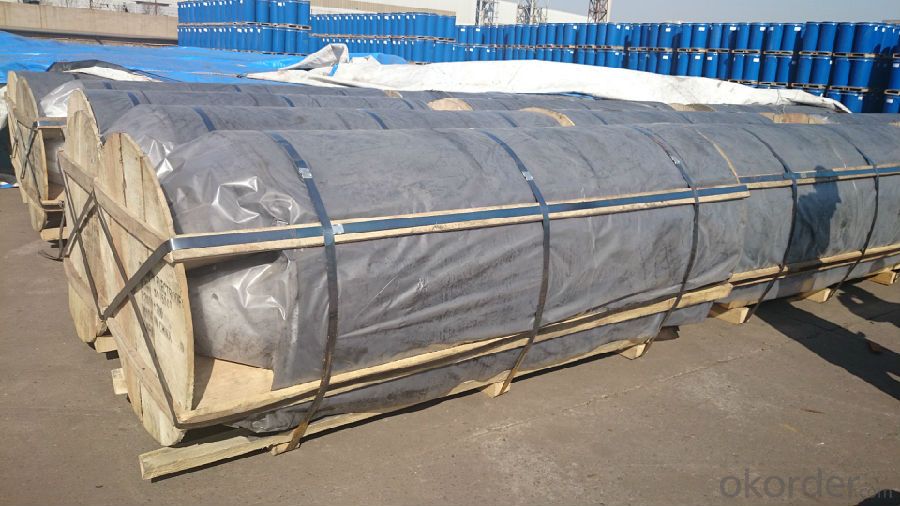
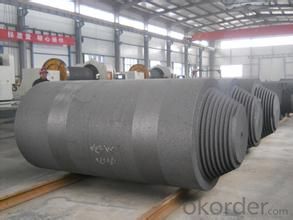
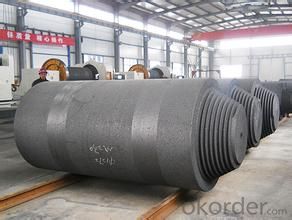
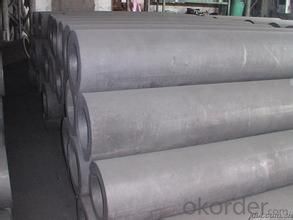
We can adjust the size based on different enquiry. please contact us if you are interested in this materials, we will send our offer as soon as get your kind email.
Do you know how many kinds of our graphite electrode?
1, according to the power, we have regular power, high power, super high power, super high power
and American Ucar standard.
2, according to the shape, we have round shape and square shape.
3, according to the size, the diameter is from 250mm to 700mm.
- Q: What can light hydrocarbon carbon five be packed with?
- Gas used as a common gas:The light hydrocarbon gas generation device (light hydrocarbon gas generating unit) consists of six basic systems and three safety systems. Includes six basic systems: the host system, fuel supply system, heat system, control system, air system, closed unloading material system. The three major safety systems include ventilation system, lightning protection system, and electrostatic heating system for light hydrocarbon gas.In operation, the working pressure in the gasifier and the static pressure and dynamic pressure of the transmission pipe network are in theBetween 0.01 and 0.02MPa, the normal operating temperature of the gasifier is no more than 45 degrees centigrade, which is lower than that stipulated by the national pressure vessel.
- Q: How does carbon affect the pH of water bodies?
- Carbon can affect the pH of water bodies through the process of carbon dioxide dissolution. When carbon dioxide dissolves in water, it forms carbonic acid, leading to a decrease in pH and making the water more acidic. This can have significant impacts on aquatic ecosystems and the organisms that inhabit them.
- Q: How does carbon dioxide affect fuel efficiency?
- Carbon dioxide does not directly affect fuel efficiency, but it is a byproduct of the combustion of fossil fuels, which are commonly used as fuel in vehicles. When fossil fuels are burned, carbon dioxide is released into the atmosphere, contributing to the greenhouse effect and climate change. However, the increased concentration of carbon dioxide in the atmosphere does not have a direct impact on the fuel efficiency of a vehicle. Fuel efficiency is primarily determined by the design and technology of the vehicle, including factors such as engine efficiency, weight, aerodynamics, and driving conditions. Nevertheless, reducing carbon dioxide emissions is crucial for mitigating climate change and promoting a sustainable future.
- Q: What are carbon offsets?
- Carbon offsets are a mechanism used to help reduce greenhouse gas emissions and combat climate change. They are essentially a way for individuals, organizations, or businesses to compensate for their own carbon dioxide (CO2) emissions by investing in projects that reduce emissions elsewhere. The concept behind carbon offsets is based on the understanding that emissions reduction can be achieved in various ways and at different costs. Instead of solely focusing on reducing their own emissions, carbon offsetting enables individuals or entities to support projects that can achieve greater emission reductions per unit of cost. These projects can include renewable energy, energy efficiency, reforestation, and methane capture, among others. To acquire carbon offsets, individuals or organizations typically calculate their own carbon footprint by assessing the amount of CO2 they emit through their activities, such as energy consumption or transportation. After quantifying their emissions, they can purchase carbon offsets equivalent to the amount of CO2 they have emitted. These offsets are generated by projects that are independently verified and certified by recognized standards and registries. Once the carbon offsets are purchased, they are effectively canceled or retired, ensuring that the emissions reduction achieved by the project is not double-counted or claimed by someone else. By investing in carbon offsets, individuals or organizations can effectively neutralize their own emissions and contribute to global efforts to address climate change. However, it is important to note that carbon offsets should not be seen as a substitute for reducing emissions at the source. They should be used as a complementary tool to support emission reduction efforts, while simultaneously implementing measures to minimize our own emissions through energy efficiency, renewable energy adoption, and sustainable practices.
- Q: What are the challenges of carbon capture and storage technology?
- Carbon capture and storage (CCS) technology shows promise as a solution for reducing greenhouse gas emissions and combating climate change. Nevertheless, there are various obstacles that must be overcome in order for it to be widely adopted and effective. One of the primary hurdles associated with CCS technology is its considerable cost. The implementation of CCS necessitates significant investments in infrastructure, equipment, and operations, making it economically burdensome. Additionally, the capture process itself requires substantial amounts of energy, resulting in increased costs and potentially limiting its feasibility. Another challenge pertains to the limited capacity for storage. Identifying suitable underground sites for storing the captured carbon dioxide (CO2) is crucial, but can be difficult due to geological limitations. The task of identifying and evaluating suitable sites with adequate storage capacity is complex and necessitates meticulous planning. Furthermore, concerns exist regarding the long-term stability and integrity of the storage sites. Leakage of stored CO2 could compromise the effectiveness of CCS and pose environmental risks. Ensuring the secure and safe storage of captured carbon is essential to prevent any adverse impacts on ecosystems and public health. Transporting the captured CO2 from the capture sites to the storage facilities also presents a challenge. Establishing an efficient and extensive transportation infrastructure is necessary for the widespread implementation of CCS technology. Developing pipelines or other means of transportation capable of handling the volume of captured CO2 and ensuring its secure transport over long distances is crucial. Public acceptance and social factors also significantly impact the challenges associated with CCS technology. Local communities may have concerns and objections regarding potential risks associated with the capture, transport, and storage of CO2. Effectively addressing these concerns through transparent communication and engagement with stakeholders is vital for garnering public support and minimizing opposition. In conclusion, carbon capture and storage technology has the potential to greatly reduce greenhouse gas emissions. However, its challenges, including high costs, limited storage capacity, integrity concerns, transportation infrastructure, and public acceptance, must be addressed to ensure successful implementation and make a significant contribution to mitigating climate change.
- Q: How is carbon used in the production of paints and pigments?
- Carbon is widely used in the production of paints and pigments due to its unique properties and versatility. One of the primary ways carbon is utilized is through the production of carbon black. Carbon black is a fine powder made from the incomplete combustion of hydrocarbons, such as coal tar, petroleum, or natural gas. It is extensively used as a pigment in various types of paints, inks, and coatings. The dark color of carbon black makes it a popular choice for providing intense black pigmentation in paints and pigments. It is highly stable and resistant to fading, which ensures that the color remains vibrant over time. Additionally, carbon black has excellent opacity, allowing it to cover other colors effectively and create a solid base for further pigmentation. Carbon black also enhances the durability and performance of paints and coatings. It acts as a reinforcing agent, improving the mechanical properties of the final product. It increases the strength, toughness, and resistance to abrasion, making the paint or coating more long-lasting and resistant to wear and tear. Furthermore, carbon black is an electrically conductive material. This property makes it a valuable component in a wide range of specialty coatings, including anti-static coatings and electromagnetic shielding coatings. These coatings are used in various industries, such as electronics, automotive, and aerospace, where electrical conductivity or protection against electromagnetic interference is critical. Apart from carbon black, other forms of carbon, such as graphite and carbon nanotubes, are also used in the production of specialized paints and pigments. Graphite is commonly used in high-performance coatings due to its lubricating properties and resistance to extreme temperatures. Carbon nanotubes, on the other hand, offer unique optical, electrical, and mechanical properties, making them suitable for advanced coatings and pigments in various applications. In summary, carbon plays a crucial role in the production of paints and pigments by providing intense black pigmentation, enhancing durability, and offering unique properties for specialized coatings. Its versatility makes it a valuable ingredient in the paint and pigment industry, ensuring the production of high-quality, long-lasting, and visually appealing products.
- Q: Where are carbon fiber sheets and carbon fiber sheets used?
- Carbon fiber is an inorganic material with good rigidity and heat resistance. Carbon fiber resin composite is a kind of plastic. It is easy to process and belongs to excellent plastics in plastics.Compared with steel, carbon fiber has the greatest advantages of low density, high strength, corrosion resistance and so on. But there are also shortcomings, the biggest drawback is poor processability. It's usually a molding (hand, roll, winding, molding and pultrusion).Carbon fiber is a brittle material, but it has high strength and is usually not used alone. But as a fiber reinforcement, it can be added to the resin matrix to improve the properties of the resin and become a high-performance composite.
- Q: How long will it last? 10National Day would like to do carbon baking ribs at home, how to do, how to marinate? For how long?.. Don't copy sticky posts. Now, tour TV's "eating meat" on earth is recorded in a grilled pork chop, wondering how that is done
- Drain the spareribs until it is dryThis can save you a lot of timeMarinate it for only about fifteen minutes with gingerIf it's thawed, pour some white wineThen mix it with salt and drain the oilFinally, dressed with bamboo ribsWhen baking, brush some oil and turn it several times halfwayThen you can use barbecue sauce when it's readyIf you don't need barbecue sauce, then mix it with salt and monosodium glutamate, and brushFinally sprinkle five spice powder, chili powder and cumin powderFinally, sprinkle chopped green onionThe time is about 8 minutesHowever, oil, not prepared in advanceAt least 30 minutes
- Q: What is carbon nanomembrane?
- A carbon nanomembrane (CNM) is a thin layer of carbon atoms arranged in a lattice structure, with a thickness of just one atom, making it one of the thinnest materials known. To create CNMs, a precursor material is deposited onto a substrate and then transformed into a pure carbon layer through heat or chemical processes. The unique properties of carbon nanomembranes have generated significant interest in science and technology fields. CNMs are highly impermeable to gases and liquids, making them ideal for applications like gas separation and filtration. They also possess excellent electrical conductivity, making them suitable for electronic devices and sensors. Moreover, carbon nanomembranes can be tailored with specific pore sizes and chemical functionalities, enabling their use in molecular sieving and biological applications. They have shown potential in drug delivery, water purification, and tissue engineering. Additionally, CNMs exhibit impressive mechanical strength and flexibility, providing opportunities for use in lightweight and flexible electronics. In conclusion, carbon nanomembranes offer a versatile and exciting platform for various applications. Ongoing research and development in this field aim to further explore and utilize the unique properties of CNMs to advance different industries.
- Q: How do you make your own carbon fiber bar?Know. ID is how to make? Don't copy anything that has nothing to do with it
- 4. application development, at present, various applications for carbon fiber annual demand ratio is as follows: sports applications of about 30%, aviation applications for 10%, industrial applications for 60%. Three important applications in sports are the golf club, fishing rod and tennis racket frame. At present, it is estimated that the annual output of big bat is 34 million. According to the national geographic classification, these big clubs are mainly made in the United States, China, Japan and Taipei, China, and the United States and Japan are the main consumer of golf clubs, accounting for more than 80%. 40% of the carbon fiber balls in the world are made from carbon fiber of TORAY. Carbon fiber fishing rods around the world produce about 20 million pairs a year, which means this application has a steady demand for carbon fiber. The market capacity of tennis racket frames is about 6 million pairs per year. Other sports applications include hockey sticks, ski sticks, archery, and bicycles, while carbon fiber is also used in rowing, rowing, surfing, and other marine sports. In 1992, the airline's demand for carbon fiber began to decline, mainly due to the decline of the commercial aircraft industry, but it recovered rapidly in the early 1995. The main reason for the recovery is that the overall efficiency of the production has been improved, but also began to fully produce Boeing 777 aircraft, TORAY carbon fiber has been used
Send your message to us
Carbon Electrodes with Diameter Φ500 to Φ700
- Loading Port:
- Lianyungang
- Payment Terms:
- TT OR LC
- Min Order Qty:
- 20 m.t.
- Supply Capability:
- 700 m.t./month
OKorder Service Pledge
OKorder Financial Service
Similar products
Hot products
Hot Searches
